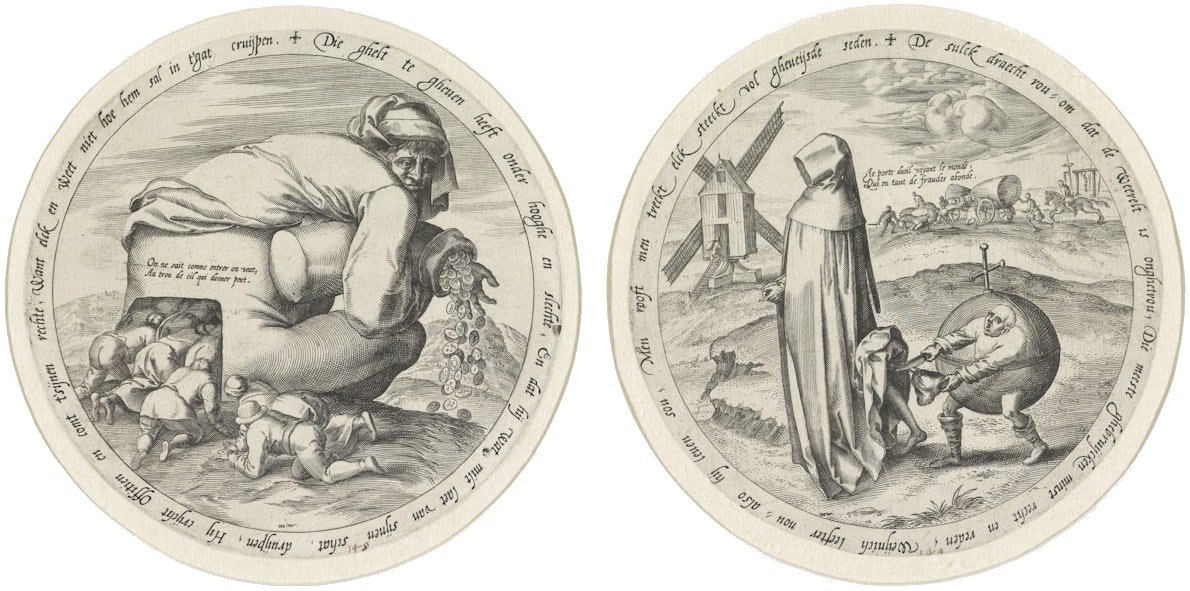
Flemish Proverbs by Jan Wierix (ca. 1568)
“I wear mourning, seeing the world in which so much deceit abounds.” So laments The Misanthrope as he skulks along, withdrawn emotionally and sartorially, in a deep-hooded cloak. But world-weariness does not amount to wisdom in Jan Wierix’s engraving; rather than serving as a hermetic sanctum, the misanthrope’s heavy garment only blinds him to the fact that the world — personified as a waddling orb — has caught up to him to steal his purse. The Misanthrope belongs to a series of twelve engraved roundels depicting literal enactments of Flemish proverbs, each concerned with some aspect of human folly or treachery. Seven of the scenes, collected below, were engraved by Wierix; the precise authorship of the remaining five remains mysterious. Rather like many actual proverbs, the Proverbs’ motifs look backward to origins that are uncertain in some respects while maintaining vitality through repetition, reuse, and appropriation.
In addition to The Misanthrope, the other six scenes engraved by Wierix include: a man shooting arrows into the ground; a hawker praising his own wares; a man playing a jawbone like a fiddle; a crowd crawling into a rich man’s asshole; a husband berated by his wife; and mendicant monks begging at unresponsive homes. The five more obscure scenes depict: the blind leading the blind; a man warming himself by his neighbor’s house fire; a fool perched on an egg; a horse frightened by an ambulant bale of hay; and an agitated peddler seated by a bride. To a contemporary anglophone audience, some of the scenes are comprehensible; for instance, the archer seems to symbolize the expenditure of energy on futile endeavors, similar to “spinning one’s wheels”. Others refer to specific Flemish proverbs of varying obscurity.
It is not known who provided the initial designs for these engravings. Pieter Bruegel the Elder had long been considered the originator of the compositions, and in fact Bruegel had supplied designs for mass-market prints early in his career. He also maintained an interest — popular in the sixteenth-century Low Countries — in literal renderings of proverbs, most famously in his painting, Dutch Proverbs, a busy scene in which around 126 proverbs are enacted before the spectator. Wierix’s Misanthrope unmistakably references Bruegel’s independent painting of the subject, and the roundel format and the count of the prints echo the circular vignettes of Bruegel’s Twelve Proverbs panel, although none of the scenes in that painting are repeated in the prints. The prints only demonstrate that the engravers, Wierix and a possible collaborator, were familiar with some of Bruegel’s imagery, not that Bruegel himself was an active participant in their production. Indeed, Walter Gibson has noted that a set of drawings initially thought to be designs for the roundels, are now considered to have been made after them, and that eleven of the twelve engravings (The Misanthrope being the one exception) may well have been designed by Wierix himself or someone else working with him.
Nevertheless, all of the engravings in the series could be described as Brugelian in their attitude and style. In addition to directly referencing an artist’s known works, imitating or attempting to elicit another artist’s manner — even in the creation of original compositions not sourced from that artist’s oeuvre — was a deliberate artistic practice in the sixteenth century. Artists and publishers kept close track of the print-buying public’s responses to their collective offerings. If a particular artist’s work became popular, it was common for others to create images in a similar vein. Indeed, none other than Bruegel himself began his career designing prints in the “mode” of a popular, elder artist: Hieronymus Bosch.
Bruegel haunts the entire Proverbs series even though he neither conceived of it nor intentionally supplied its designs. His spectral presence affected their reception and future iterations. Several of the Proverbs were reformulated in later prints, and two painted versions of the crawling brownnosers were created by none other than Bruegel’s son, Pieter Bruegel the Younger.
“The music of the rich is always pleasant, even if played on a jawbone”
“Every peddler praises his own wares”
“Knocking at a deaf man’s door”
“Because so much money creeps into my sack, the whole world climbs into my hole”
“Because the world is so deceitful, I go in mourning”
“To shoot all one’s bolts”
“A whistling woman and a crowing hen are neither fit for God nor men”
Mar 14, 2024









